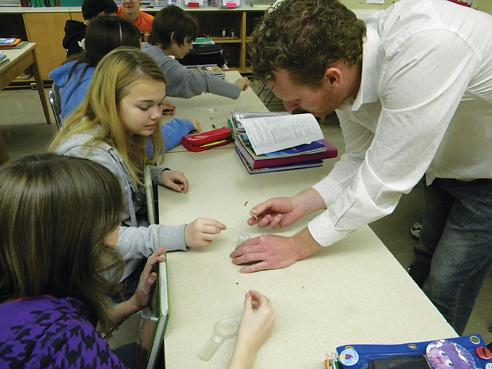Symbi program takes graduate students out of labs, into K-12 classrooms

Mark Newell, graduate in agronomy teaches students at Brody Middle School in Des Moines about pollination.
November 26, 2012
Iowa State’s program Symbi gives graduate students in science, engineering and mathematics fields a chance to introduce their research to a younger audience. Symbi is funded by the National Science Foundation.
Adah Leshem, program director of Symbi and the Iowa State Center for Biorenewable Chemicals, believes the interaction between scientists and younger audiences is a vital experience for both groups.
“The goal of the program is to provide graduate students in STEM career opportunities to strengthen their communication skills,” Leshem said.
Symbi fellows also learn to adapt their knowledge and research explanations to different audiences in a way younger students would understand.
Paul Skrade, a Symbi fellow and ISU graduate student in natural resource ecology and management, explains some of the benefits of the program.
“It’s an opportunity for us to speak with a nontechnical audience. A lot of people struggle with being able to communicate with the general public,” Skrade said. “This is a way for us to get a jump start on that.”
Tom Garrison, a Symbi fellow and graduate student in chemistry, discussed the potential difficulty of reaching a significantly less experienced audience.
“I’m doing high level academic research, and I have to be able to communicate to somebody who is learning chemistry for the very first time,” Garrison said. “How do you communicate with someone who is intelligent but does not have the knowledge base?”
One technique for teaching these ideas is what the fellows call “scaffolding,” which relates the unknown material to a subject students already know to help them understand the next level of concepts.
Symbi places graduate students in the classrooms of kindergarten through 12th graders, where they act as resident scientists and engineers and share their work interactively.
“By being in the classroom they are providing the K-12 students with amazing opportunities to work directly with a scientist or engineer,” Leshem said.
Early introduction to research and sciences beyond the general curriculum is particularly important. Most students won’t engage in these fields until they’re in college.
Skrade said collaborating teachers get a stipend to buy classroom supplies and additional training.
“Mainly what I do is I go down there and try to come up with science demonstrations or activities that relate to the curriculum, but connect to real-world research,” Garrison said. “I have an interest in becoming a professor, and I had already had teaching experience as a teaching assistant. I saw this as a continuation of that teaching experience.”
Skrade recently brought his seventh-grade class from Brody Middle School on a field trip to Gray’s Lake, about a mile from the middle school. The class tested the water quality and submitted the results to a water monitoring database.
“They could see that what we were doing was part of a bigger program,” Skrade said. “It helped them connect science, education and their environment.”
The benefits of Symbi, Garrison said, are scientists become recognizable figures in the life of younger students and not as an abstract concept, like a mad scientist in a cartoon show.
“The students get a perspective that scientists are not just somebody in a movie or a TV show,” Garrison said. “They’re real people, and they have real interests outside of the classroom, outside of the lab. … This is an actual career that you can go into.”
On occasion, students are also able to take day trips to visit Iowa State and see the laboratories their resident Symbi scientists work in.
The ideas and experiences Symbi fellows bring back to Iowa State with them spread into their research groups. In turn, professors become more in tune with the abilities and possible communication issues with students on the K-12 level in the central Iowa region.
Although the National Science Foundation will end its funding to the Symbi program in 2015, Leshem said there will be efforts to institutionalize the program at Iowa State.
















